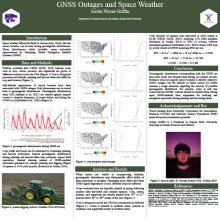GNSS Outages and Space Weather
Austin
Griffin
Kansas State University
Poster
GNSS Outages and Space Weather
One of the demonstrations shown via space weather that directly affects the Earth is displayed as the aurora borealis. Another way that space weather indirectly affects crop growth and development on Earth is by preventing satellite signals from going through the Earth's ionosphere to reach farm equipment.
Since 1932, geomagnetic disturbances have been charted to visualize the frequency of events before and during the GNSS era. Crop yields can be estimated by comparing planting proficiency during years with intense geomagnetic disturbances throughout most active planting and harvest dates.
Geomagnetic disturbances directly affect GNSS satellite signals from traveling through the ionosphere as predicted disturbances affect the ability of precision agricultural technology from obtaining its current location and in turn makes crop planting and harvesting less accurate.
Two graphs, one over space weather levels v.s. the aurora borealis and the other on crop yield/planting in the northern United States, show how space weather from the sun affects crop yield/planting
Results from the information gathered imply that geomagnetic disturbances at the beginning of the GNSS era became a much less frequent occurrence then of our earliest records. The evidence provided doesn't support the idea that the aurora borealis is directly related to the GNSS outages, but the aurora borealis is still a rough easement on how severe a geomagnetic event could be. We should exude caution when relying upon farm equipment that uses GNSS-enable tracking and navigation for planting and harvesting.
One of the demonstrations shown via space weather that directly affects the Earth is displayed as the aurora borealis. Another way that space weather indirectly affects crop growth and development on Earth is by preventing satellite signals from going through the Earth's ionosphere to reach farm equipment.
Since 1932, geomagnetic disturbances have been charted to visualize the frequency of events before and during the GNSS era. Crop yields can be estimated by comparing planting proficiency during years with intense geomagnetic disturbances throughout most active planting and harvest dates.
Geomagnetic disturbances directly affect GNSS satellite signals from traveling through the ionosphere as predicted disturbances affect the ability of precision agricultural technology from obtaining its current location and in turn makes crop planting and harvesting less accurate.
Two graphs, one over space weather levels v.s. the aurora borealis and the other on crop yield/planting in the northern United States, show how space weather from the sun affects crop yield/planting
Results from the information gathered imply that geomagnetic disturbances at the beginning of the GNSS era became a much less frequent occurrence then of our earliest records. The evidence provided doesn't support the idea that the aurora borealis is directly related to the GNSS outages, but the aurora borealis is still a rough easement on how severe a geomagnetic event could be. We should exude caution when relying upon farm equipment that uses GNSS-enable tracking and navigation for planting and harvesting.

Poster PDF
Poster category
Ionosphere and Thermosphere Research and Applications
Meeting homepage